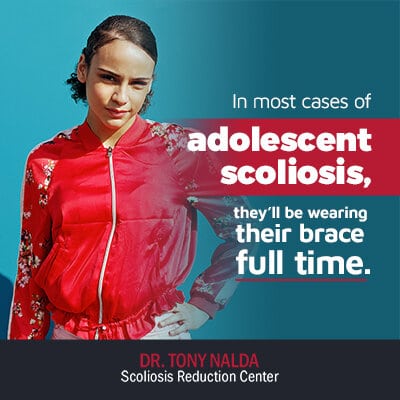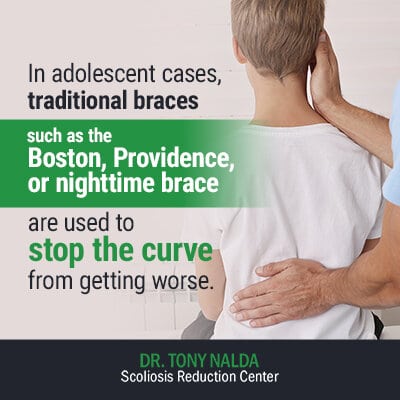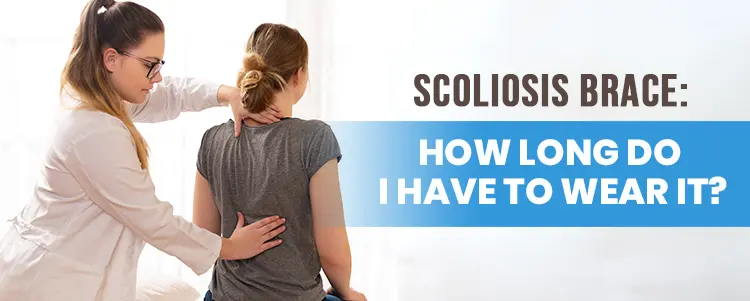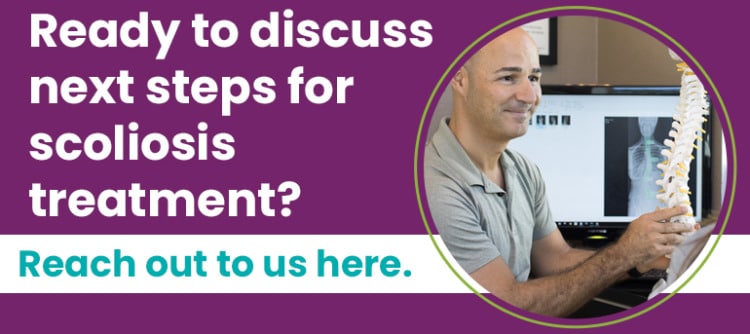When we look at using bracing to treat scoliosis, there are two types of patients we brace: skeletally-immature, meaning children, and skeletally-mature, meaning adults. Among children, adolescent idiopathic scoliosis (AIS) is a predominant form of spinal deformity, often progressing during growth spurts around puberty. How long a patient has to wear a brace depends on their condition, age, and the treatment goal of the bracing.
As bracing can be used to treat scoliosis in both adults and children, there are some significant differences in what the goal of treatment is, along with the differences between traditional and corrective bracing. Let’s first take a look at prescribing bracing for skeletally-immature patients.
Understanding Scoliosis
Scoliosis is a medical condition characterized by an abnormal curvature of the spine, which can appear as an “S” or “C” shape when viewed from the back. This condition can affect individuals of all ages, but it is most commonly diagnosed in adolescents and young adults. The causes of scoliosis are varied and can include genetic factors, neuromuscular conditions, and uneven muscle development.
The severity of scoliosis can range from mild to severe, with symptoms that may include back pain, uneven shoulders or waistline, and in more serious cases, breathing difficulties. Early detection and treatment are crucial in preventing the progression of scoliosis and reducing the risk of complications. Regular check-ups and monitoring can help manage the condition effectively, ensuring a better quality of life for those affected.
Scoliosis Bracing Overview
Scoliosis bracing is a non-surgical treatment option designed to prevent the progression of spinal curves in patients with scoliosis. Typically recommended for those with moderate scoliosis, defined as a curvature of 25-40 degrees, bracing aims to halt the curve’s progression and reduce the need for surgical intervention.
Bracing is particularly effective in skeletally immature patients, as their spines are still growing and more adaptable to correction. There are several types of scoliosis braces available, each tailored to specific needs. The Boston Brace, for example, is a commonly used full-time brace that helps immobilize the spine to prevent curve progression. The Charleston Bending Brace, on the other hand, is worn only at night and works by bending the spine in the opposite direction of the curve. Each type of brace has its unique approach, but the ultimate goal remains the same: to manage scoliosis effectively and improve the patient’s quality of life.
Bracing for Children with Scoliosis
When we talk about bracing skeletally-immature patients, we’re talking about treating children that fall into one of three categories: infantile, juvenile, and adolescent.
- Infant: less than 2 years of age
- Juvenile: between the ages of 2 and 10
- Adolescent: between the ages of 10 and 16
Bracing for Children with Scoliosis
When we talk about bracing skeletally-immature patients, we’re talking about treating children that fall into one of three categories: infantile, juvenile, and adolescent.
- Infant: less than 2 years of age
- Juvenile: between the ages of 2 and 10
- Adolescent: between the ages of 10 and 16
Infant and Juvenile Bracing
In infant and juvenile cases, we generally try bracing until the curve is reduced enough to be taken off the brace. For example, we’ll use full-time bracing to reduce the curve, and then we’ll try to wean them from the brace until they reach the adolescent stage; the reason we do this is because the adolescent stage has the highest risk of progression.
Let’s say we have a six year old and we treat their scoliosis with full-time bracing for a year to 18 months. We would continue that course of treatment until we’ve reduced and stabilized the curve. From there, we might wean them from the brace until they’re 11 or 12 years of age, and then we’ll observe what happens to their curve when they have a growth spurt.
If progression occurs alongside a growth spurt, then we’ll put them back in a full-time brace that they’ll wear through the adolescent phase until they’ve reached skeletal maturity.
In infantile and juvenile cases, that’s our goal: to get them to the adolescent phase.
Adolescent Bracing

If an adolescent comes into our office for treatment and is in need of bracing, they’ll normally stay in their brace until they’re skeletally mature; we don’t want to wean them off wearing them too early because of the high risk of progression.
In most cases of adolescent scoliosis, they’ll be wearing their brace full time. The reason for full-time wearing is that we know there’s a big difference between bracing to ‘hold’ the curve and bracing to ‘reduce’ the curve and make the spine straighter.
I like to use the example of wearing orthodontic braces on your teeth. No one would expect to wear braces only part time to get the same results that full-time wearers would get. Straight teeth are the result of wearing braces full time with regular tightenings and adjustments.
Full-time bracing means wearing it 18 to 23 hours a day. This five-hour time range is dependent upon the patient, with the average wearing time falling in the middle at around 21 hours a day.
Adolescents will wear their brace for the prescribed amount of time, until we get them to the adult stage, and then we wean them from it very, very slowly over a certain period of time.
When it comes to using bracing for adults, there are two different approaches we can take.
Bracing for Adults with Scoliosis
When it comes to bracing in adults, we have two different treatment goals: to reduce pain or to reduce the curve.
If the goal is to reduce scoliosis-related pain, adults would wear the brace part time, for 4 to 6 hours a day. If an adult patient still has flexibility in the spine because of having gone through treatment, we can treat them as we would an adolescent, meaning wearing the brace full time. An orthopedic surgeon can provide professional guidance and custom treatments to ensure effective care and management for adult scoliosis patients.
Depending on the size of the patient’s curve and the rigidity of their spine, this would mean wearing the brace for 6 to 18 months and then weaning them down from wearing a corrective to a traditional supportive brace, or completely out of bracing.
The question of how long adults have to wear their braces for is a tricky one to answer because it varies from patient to patient. A big determining factor is the age of the adult.
With young adults, we’re often able to wean them off bracing completely. If it’s an elderly adult with degenerative scoliosis that’s rapidly progressed, they might have to wear a brace for the rest of their lives, although likely not full time. This sounds extreme, but if you think of an adult who’s had spinal-fusion surgery to treat their scoliosis, that means having a metal rod attached to the spine for the rest of their life.
This is the protocol with corrective bracing because the treatment goal is what it sounds like: correction. Corrective bracing aims to physically reduce the curvature.
This takes us into the difference between traditional supportive bracing that aims to stop progression, versus corrective bracing that aims to achieve a structural change.
Traditional Bracing vs. Corrective Bracing
The big difference between traditional supportive bracing and the type of corrective bracing that we use here at the Scoliosis Reduction Center® is in their efficacy and treatment goals. Traditional bracing is used to either reduce pain in adults or to stop progression; in corrective bracing, the goal is to achieve a structural change by physically reducing the curve. One ‘holds’ and one ‘corrects’. This distinction is crucial in scoliosis brace treatment, where factors such as the severity of the condition, growth stages, and medical advice play significant roles.

I feel traditional bracing is somewhat useless for adults. It does little to reduce pain, nor does it reduce the curve. The brace acts as a cast on the spine causing immobilization. Immobilization causes weakness, and that weakness tends to lead to more problems. In adolescent cases, traditional braces such as the Boston, Providence, or nighttime brace are used to stop the curve from getting worse.
The two most common traditional braces are the Boston and the Providence. Boston braces tend to be prescribed as full time and are squeezing braces that cause immobilization; they’re not designed to reduce the curve, and they’re not even that effective at stopping progression.
Another shortfall of traditional bracing is that they’re generally prescribed to be worn 18 to 23 hours a day. They also get more and more difficult to wear for children and adolescents because their curves are still progressing while the brace is squeezing the spine and trying to hold it in place. This is where tolerance and compliance can be a challenge, especially with younger patients.
When it comes to the Charleston, Providence, or nighttime braces that are only worn during sleep, they make the patient bend while they squeeze and bend the spine, but they don’t provide enough of a dose to actually change the spine’s shape.
This failure of traditional bracing to change the spine’s shape is what leads to such high failure rates, unlike corrective bracing results.
Corrective Bracing and Curve Progression
Here at the Scoliosis Reduction Center®, we believe that bracing does have a place in treating scoliosis, but only if it’s corrective, such as our customized ScoliBrace®. Our ScoliBrace® represents a new generation of corrective bracing, and when used to its full potential and monitored and adjusted properly, it becomes a valuable facet of scoliosis treatment by addressing spinal curvature.
Most traditional braces that are prescribed, however, are rarely altered. A patient will be given their brace and never given another until they have either outgrown it, or the course of treatment ends.
To return to the example of orthodontic braces, how effective would braces be at correcting crooked teeth if they were never tightened or adjusted, or only worn part time? This is why the theory behind traditional bracing doesn’t make sense to me.
In order for a brace to actually work, it needs to be corrective, customized, and constantly adjusted to adapt to the growing body wearing it, especially when it comes to reducing the curve and not just holding it in place.
This is another big difference between traditional and corrective bracing: traditional bracing doesn’t involve modifications that are necessary to push the spine straighter with the same intensity. This step’s completely missed in traditional bracing.
With corrective bracing, such as our ScoliBrace®, part of our treatment approach is to manage the brace by adjusting it every few months to get the highest level of curvature reduction possible.
Living with a Scoliosis Brace
Wearing a scoliosis brace can be challenging, but adhering to the recommended wear schedule is essential for achieving the best results. Patients are typically advised to wear their brace for 16-23 hours per day, with breaks allowed for sports and showering or bathing.
Initially, it may take some time to get used to wearing a brace, but most patients find that it becomes more comfortable over time. It’s important to continue participating in sports and physical activities while wearing a brace, as staying active can help maintain overall health and well-being. However, patients should discuss their specific needs and any concerns with their doctor to ensure they are following the best practices for their situation. Regular follow-up appointments are crucial for monitoring progress and making any necessary adjustments to the brace.
Alternative Treatments for Scoliosis
While bracing is a common and effective treatment option for scoliosis, there are alternative treatments available that can complement or, in some cases, replace bracing. Physical therapy is one such option, focusing on improving posture, strength, and flexibility. It can be particularly beneficial when used alongside bracing, helping to enhance the overall treatment outcome.
Schroth therapy is another alternative, involving scoliosis-specific exercises that combine strength-building and breathing exercises with posture awareness. This method aims to improve spinal alignment and reduce the curvature. Other treatments, such as chiropractic care and acupuncture, may also offer benefits in managing scoliosis symptoms. However, it is essential to discuss these options with a doctor before starting any new treatment to ensure they are appropriate and effective for the individual’s specific condition.
Getting Fitted for a Scoliosis Brace
Getting fitted for a scoliosis brace involves a consultation with an orthotist, a professional who specializes in creating and fitting braces. During the fitting process, the orthotist will take precise measurements of the patient’s torso to design a custom-made brace tailored to their specific needs.
The brace is designed to apply pressure to the outer edge of the curve, encouraging the patient to stand up straighter and preventing the curve from worsening. The fitting process can take several weeks, and patients may need to return to the orthotist’s office for adjustments to ensure the brace fits properly and comfortably. Working with an experienced orthotist is crucial for achieving the best possible results and ensuring the brace is effective in managing the scoliosis.
Insurance and Costs
Scoliosis bracing is typically covered by insurance, but the specific coverage and costs can vary depending on the insurance provider and the type of brace prescribed. Patients should discuss their insurance coverage and potential costs with their doctor and orthotist before starting treatment to avoid any unexpected expenses.
The cost of a scoliosis brace can range from $5,000 to $10,000 or more, depending on the type of brace and the complexity of the case. Additionally, patients may need to pay for follow-up appointments and adjustments, which can add to the overall cost of treatment. However, the cost of bracing is often less than the cost of surgery, making it a valuable investment in preventing the progression of scoliosis and improving the patient’s quality of life.
Conclusion
As a complex condition that varies greatly from one patient to the next, the chosen treatment approach can also vary. Here at the Scoliosis Reduction Center®, our patients have access to multiple forms of treatment, including our corrective ScoliBrace®.
The ScoliBrace® represents the culmination of bracing theory and practice that addresses the underlying structural issue of a patient’s scoliosis. This is the difference between traditional and corrective bracing as the former aims to stop a curvature from progressing, but does nothing to actually reduce the curve and address the underlying issue of the condition; the latter can achieve a structural change by changing the shape of the spine.
When it comes to how long a patient has to wear their brace for, that depends on factors such as their age, condition type, and treatment goal.
If bracing is used to reduce pain in adults, this most often means wearing it for 4 to 6 hours a day. If an adult has gone through our scoliosis-specific chiropractic treatment and has increased flexibility in their spine as a result, we can treat them like our adolescent patients and get them in a corrective brace full time for anywhere from 6 to 18 months.
When it comes to children and adolescents, the length of time to wear a brace will depend on whether or not they’ve reached skeletal maturity. For infants and juveniles, we’ll generally have them in a brace until their curvature has been reduced, or they reach the adolescent phase; whether or not they have to continue wearing it during adolescence depends on our observations of how growth affects their curvature. For adolescents, they will most often be wearing their brace full time until they reach skeletal maturity.
In general, if the treatment goal of bracing is support and pain reduction, it will be worn for 4 to 6 hours a day; if the treatment goal is curvature reduction, it will need to be worn full time, meaning around 20 to 23 hours a day.





